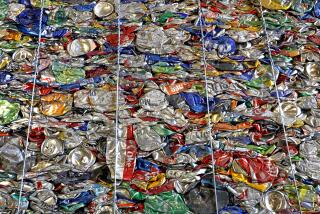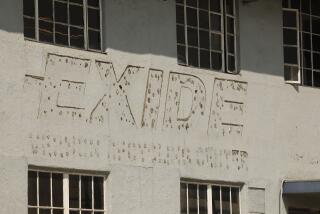L.A. to Recycle Trash of 5 Neighborhoods
Los Angeles officials soon will ask about 1,500 families in the Valley to start separating recyclable materials from other trash as part of a pilot program to conserve dwindling landfill space. The voluntary program, which could be expanded citywide, will involve separate curbside pickup of metal cans, glass containers and newspapers--easily recyclable materials that make up about 20% of the weight of household trash.
Scheduled to start about Oct. 1, the project will be similar to those already operated by Los Angeles on the Westside, where the level of participation is high, and by Burbank.
“We really believe it is the future for the city,” Greig Smith, an aide to Councilman Hal Bernson, said of the experiment. “We need to do everything we can to cut the waste stream into the canyons.”
Special Container
Robert Alpern, principal sanitary engineer with the city Bureau of Sanitation, said that residents of single-family homes in the targeted Valley neighborhoods will be contacted within the next few weeks and issued a special 20-gallon drum to hold metal cans, glass and newspapers.
The materials will be picked up in a special refuse truck, designed and built at a cost of $145,000, with a compartment for ordinary trash and another for recyclables.
The truck will operate on five existing trash routes in neighborhoods chosen by Bernson and fellow City Council members Howard Finn and Joy Picus, both longtime advocates of recycling. Although each household on the chosen routes will be asked to participate, there will be no penalty for those who do not.
The designated routes are near the intersections of Chatsworth Street and Zelzah Avenue in Granada Hills, Polk Street and the Foothill Freeway in Sylmar, O’Dell Avenue and Apperson Street in Sunland, Fallbrook Avenue and Oxnard Street in Woodland Hills and in the area of Zelzah Avenue and Hatteras Street in Encino.
Sanitation officials said the Valley program will operate at least several months. They said if the response is good and the Westside program continues to be a success, it may be expanded citywide.
Life Span of Dumps
According to a report by Los Angeles County officials, the amount of trash now being generated would fill all the landfill space in the county within seven years. Officials say any unexpected landfill closures, for environmental or other reasons, could cut the life span of other dumps.
More than 80% of the more than 1.3 million tons of household trash collected annually by the City of Los Angeles goes into landfills in or near the San Fernando Valley.
The Lopez Canyon landfill above Lake View Terrace--the only operating city-owned trash dump--receives more than half the household trash collected in the city. Much of the remainder goes to the privately owned Sunshine Canyon landfill above Granada Hills and the county’s Calabasas landfill in Agoura.
Not only is space in landfills decreasing, but environmental concerns are building over their continued use. A U. S. Environmental Protection Agency official has compared the so-called “good” landfill to a bomb with a long fuse--a reference to the fact that all landfills eventually leak, threatening ground water supplies. And even a landfill that never received industrial waste contains at least small quantities of hazardous material from residential areas: used motor oil and residues of pesticide, solvents and paint, for example.
On top of those concerns, fierce neighborhood resistance makes creating new landfills “anywhere in the country today . . . almost impossible,” Alpern said.
Even optimistic supporters of the program acknowledge that it is merely part of the answer. Household trash represents only about a third of the total non-hazardous solid waste, and cans, glass and newspapers constitute only 20% of that.
‘It Helps’
“It doesn’t do it all, and it can’t do it all, but it helps,” Picus said.
Fredrika Bernstein, a Sierra Club member from Sherman Oaks who serves on the county’s Solid Waste Management Committee, called curbside programs “an opening wedge” that at least “gets people to understand what they’re doing when they throw things out.”
Along with recycling, the city is banking heavily on the use of waste-to-energy plants, known as the LANCER (Los Angeles City Energy Recovery) projects. The first of these huge incinerators could be operating by 1989 in Central Los Angeles if neighborhood and air pollution concerns can be overcome.
The plant would generate electric power while turning 30% of the city’s household trash into ash that would take up a tenth of the landfill space.
The City Council recently authorized a search for two more LANCER sites--one in West Los Angeles and the other in the Valley, to be built in the 1990s.
Recycling Elsewhere
Although many waste-to-energy plants have been proposed, none are yet operating in California. On the other hand, curbside recycling is being done in about 30 California cities, according to Dennis Stone, an official with the California Waste Management Board, which provided seed money in the early 1980s for many of the programs.
Along with Los Angeles and Burbank, Santa Monica, Redondo Beach, Downey, Oceanside and Claremont are operating curbside recycling programs, Stone said.
The Burbank Recycle program began in 1982 under a contract between the city and a division of Garden State Paper Co., the country’s largest producer of newsprint from recycled paper.
The program serves all of Burbank’s 18,500 single-family households, picking up their recyclable trash every other week on the regular trash day.
The ordinary trash is collected by regular city crews, while Garden State employees service the neighborhoods in city-owned trucks that have bins for papers, cans and glass.
Of about 6,000 tons a month of city-collected refuse, 600 tons of recyclable trash is processed through the Burbank Recycle center at 720 N. Lake Street, officials say.
However, most of this recycled material is not gathered at the curb but brought to the center by residents and sold for cash. Only about 20% to 25% of Burbank families put their recyclables out by the street, according to Gene Owsley, manager of the recycling center.
High Participation
On the other hand, the Westside program, which started in the spring of 1985, has enjoyed a participation rate as high as 70%, according to city officials.
The program, targeted at nearly 13,000 single-family homes in Pacific Palisades, Brentwood and adjoining neighborhoods, during an average month diverts from 9% to 10% of the trash that would otherwise go to a landfill, according to city statistics. The glass, cans and paper are sold to a recycler, which reduces the city’s net operating cost to $1 per household per month, officials said.
The peak participation of 70% is exceptionally high, since those who don’t take part but recycle on their own are not counted. Lately, however, participation has slacked off somewhat, causing city officials to renew the publicity campaign.
“This kind of program requires constant public relations,” Alpern said. “Until it becomes a regular city activity,” he said, homeowners “have to be reminded of the need for it.”
The Valley project is being set up to make involvement almost effortless. Materials need not be saved in separate containers, and remembering the day should be easy since pickup will be each regular trash day.
Referring to residents, Rick Kunz, an aide to Howard Finn, said, “What we’re hoping is that the more convenient you make it for them, the more likely they are to participate.” If voluntary appeals don’t work, Kunz said, Finn eventually may propose that a fee be charged to people who do not separate their trash.
City officials and environmentalists have discussed other ideas for reducing trash, including attacking excessive packaging.
At one time, Picus said, she considered organizing a boycott of overpackaged goods. But the campaign “really didn’t get off the ground,” she said.
Bernstein suggested voluntary labeling to show which packaging is made of recycled material. That way, she said, consumers would have a way to support businesses that recycle.
More to Read
Sign up for Essential California
The most important California stories and recommendations in your inbox every morning.
You may occasionally receive promotional content from the Los Angeles Times.










